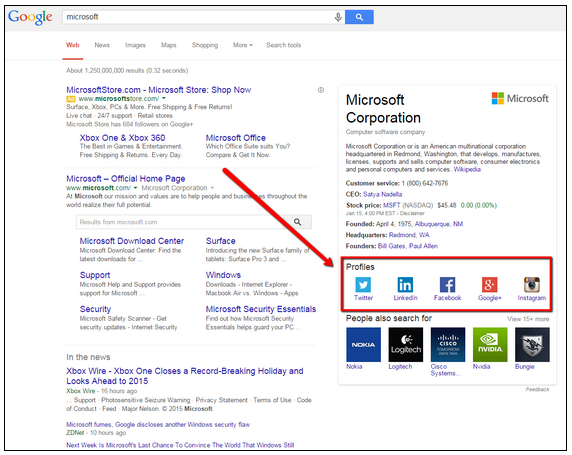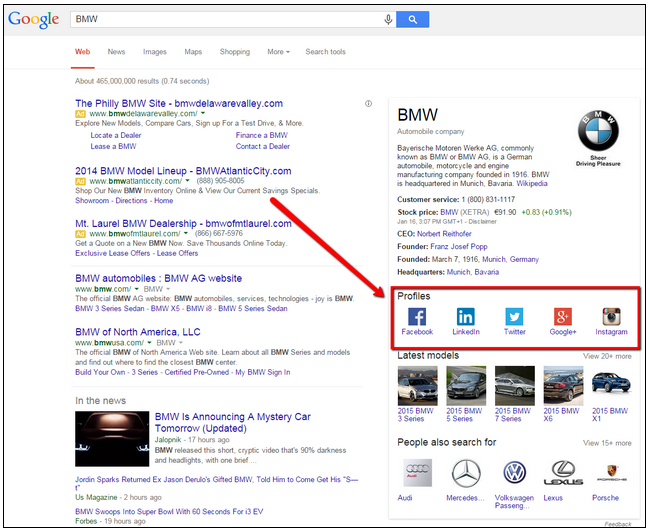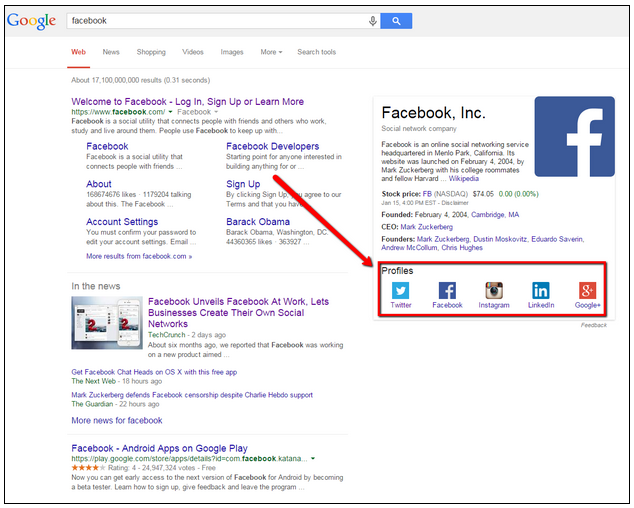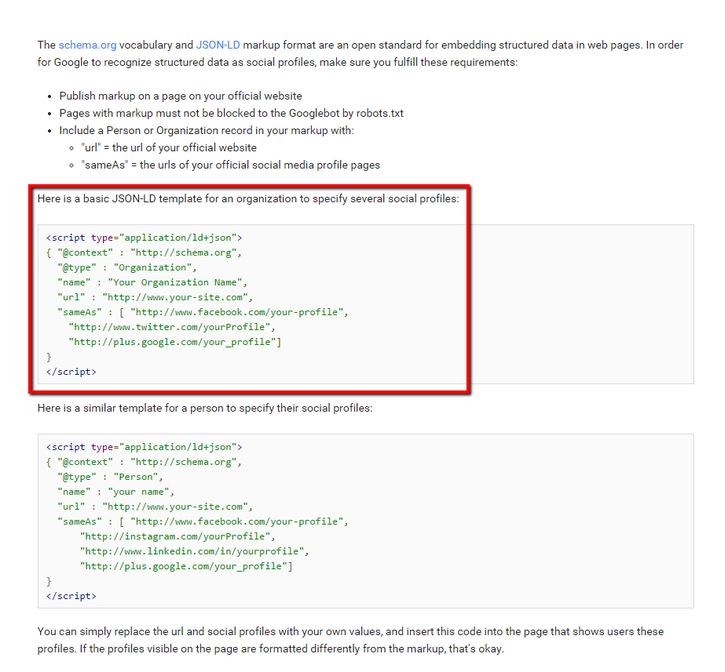Brand Social Media Profiles In Google’s Knowledge Graph: How To Get There & What It Means for Marketers
If you’ve Googled some of your favorite brands lately, you may have noticed something new showing up in the results pages. As of early this year, Google has included brands’ social profiles outside of Google+ within the knowledge graph. This feature was previously reserved for famous personalities such as actors, musicians and political figures, but is now widely available for brands.
Brands can now specify the following social profiles to show up in the knowledge graph:
- Google+
- YouTube
- Myspace
Here’s how this plays out for Microsoft:

Here’s a search for BMW:

And you guessed it, Facebook is also on Twitter, Google+, and LinkedIn:

Pretty fancy, huh? More examples from Search Engine Land.
How to get your brand’s social profile in the knowledge graph
Google has released new structured data markup to specify social profiles in search results. This allows you to use specified markup on your official website to show social profiles in the knowledge graph.
The main takeaways from the release are the following:
- “For sites that have a verification process, Google will only show verified profiles.” This means that on social sites such as Twitter and Facebook, you must be verified to show up in the knowledge graph
- “The social profiles in your markup must correspond to the ones that users can see on the same page”
- Here’s the markup and its requirements from Google’s release:

From our observations thus far, the best way to ensure that Google includes your brand’s social profiles in the knowledge graph is to mark them up on your website. Using the markup code to specify exactly which social profiles you want included in the knowledge graph will more likely than not land you in the knowledge graph if you meet Google’s other requirements.
You could also resort to leaving feedback if they're aren't updated after you implement these markup changes:
"If all looks correct, and you have waited at least one week since your marked-up page was last crawled by Google, report the missing events using the small "Feedback" link under the Knowledge Graph panel in Google search. Click "Wrong?" on your company's name and explain the problem, being sure to use the term "social profiles" in your description of the problem."
- excerpt from http://www.google.com/insidesearch/features/search/knowledge.html
It’s important to note that:
“even if you don't include this markup on your page, Google algorithms may find information that is publicly available on the web and include it in the knowledge graph. If you don’t want your social profiles to show up in the knowledge graph, you can use the specified markup to override the information Google finds automatically, but you can't specify not to list a social profile.”
- excerpt from http://www.google.com/insidesearch/features/search/knowledge.html
What does this mean for marketers?
When we began discussing the implications of this internally at Seer, Stephen Gerard highlighted a few very practical positives and negatives from a marketing perspective:
"...I can see this helping or hurting some of our clients. If they're running social media initiatives that promote great content, this could prove to help increase referral traffic to certain pages on the site. If they aren't running social media campaigns or updating their profiles consistently, it could lead users to having a poor experience."
 Stephen Gerard, SEO Associate, Seer Philly
Stephen Gerard, SEO Associate, Seer Philly
I think Stephen’s ideas are spot on. An additional opportunity (or threat for some) could be that if social channels start trending towards the knowledge graph and begin exiting the organic SERPs, there is more real estate previously owned by social channels in organic space (often page one) that would theoretically be made up for grabs. We’ve seen this phenomenon go both ways for brands in the knowledge graph thus far, so it will be interesting to observe how things progress going forward.
Also, it's important to understand why Google thinks that social fits into the knowledge graph in order to understand how it can benefit your brand. The goal of the knowledge graph is that users are able to use this information to resolve their query without having to navigate to other sites and assemble the information themselves.
This must mean that A LOT of people who are searching for brands are also searching for their social profiles. If your brand isn’t on any or every social network, you may come off as less trustworthy compared to your competitors and it may ultimately hurt your bottom line.
Social networks such as Facebook adding call to action buttons to their pages feed into this greater trend of social sites holding more stock on the internet and in SERPs. And it should come as no surprise given how much time users are spending on these sites. As not only SEOs but as digital marketers we should ask ourselves questions like:
- "Can users easily navigate from my social profile to meaningful (to both the brand and to the user) pages on my site? When they get to my site from a social channel, what percentage convert compared to those who arrive from an organic SERP, email, PPC, etc."
- "If I’m an ecommerce site, what do the typical paths from my social channels to my checkout page look like? Are they too long?"
- How does social not only impact acquisition and conversions, but how does it fit into my customer support goals, recruiting initiatives, etc.
- Am I generating valuable content on a consistent basis, and are influencers in my industry sharing it?
Marketers who are able to effectively answers questions like these will be able to leverage increased social visibility from Google’s knowledge graph, and ultimately generate more value from their social strategies.


